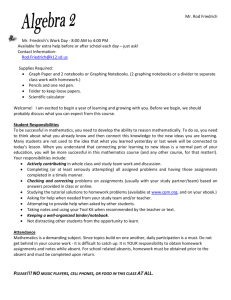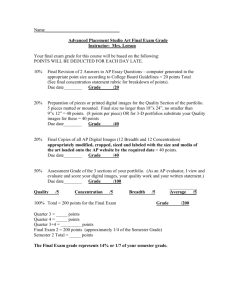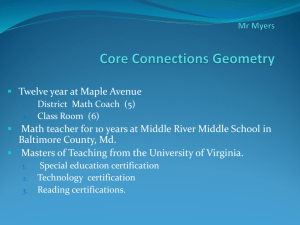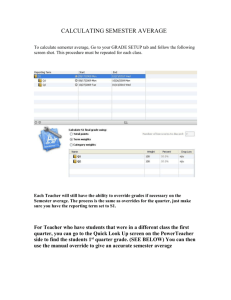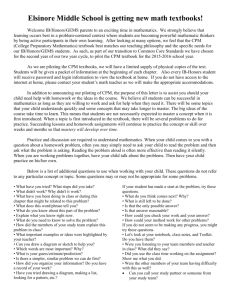Please!!! NO music players, cell phones, or food in this class AT ALL.
advertisement
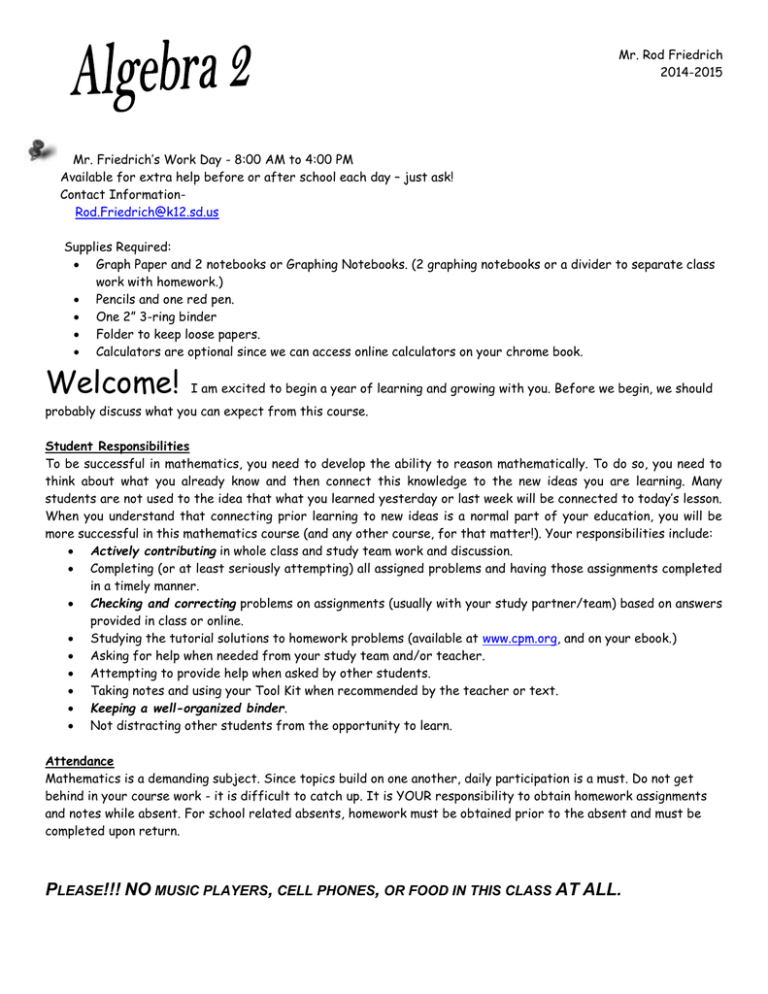
Mr. Rod Friedrich 2014-2015 Mr. Friedrich’s Work Day - 8:00 AM to 4:00 PM Available for extra help before or after school each day – just ask! Contact InformationRod.Friedrich@k12.sd.us Supplies Required: Graph Paper and 2 notebooks or Graphing Notebooks. (2 graphing notebooks or a divider to separate class work with homework.) Pencils and one red pen. One 2” 3-ring binder Folder to keep loose papers. Calculators are optional since we can access online calculators on your chrome book. Welcome! I am excited to begin a year of learning and growing with you. Before we begin, we should probably discuss what you can expect from this course. Student Responsibilities To be successful in mathematics, you need to develop the ability to reason mathematically. To do so, you need to think about what you already know and then connect this knowledge to the new ideas you are learning. Many students are not used to the idea that what you learned yesterday or last week will be connected to today’s lesson. When you understand that connecting prior learning to new ideas is a normal part of your education, you will be more successful in this mathematics course (and any other course, for that matter!). Your responsibilities include: Actively contributing in whole class and study team work and discussion. Completing (or at least seriously attempting) all assigned problems and having those assignments completed in a timely manner. Checking and correcting problems on assignments (usually with your study partner/team) based on answers provided in class or online. Studying the tutorial solutions to homework problems (available at www.cpm.org, and on your ebook.) Asking for help when needed from your study team and/or teacher. Attempting to provide help when asked by other students. Taking notes and using your Tool Kit when recommended by the teacher or text. Keeping a well-organized binder. Not distracting other students from the opportunity to learn. Attendance Mathematics is a demanding subject. Since topics build on one another, daily participation is a must. Do not get behind in your course work - it is difficult to catch up. It is YOUR responsibility to obtain homework assignments and notes while absent. For school related absents, homework must be obtained prior to the absent and must be completed upon return. PLEASE!!! NO MUSIC PLAYERS, CELL PHONES, OR FOOD IN THIS CLASS AT ALL. Assessment Your nine-week grade is determined by combining several assessments— homework, participation, learning logs, projects, quizzes, and tests. Each assessment is designed to allow a maximum demonstration of your knowledge. On each assessment you should be able to illustrate in a neat, organized, and polished manner what you have learned. Be sure to try your best on each. DO NOT GIVE UP!! Test corrections (on individual tests) will be given to those students who have no zeros for that chapter. The student will have one week to complete their test corrections. Test corrections can be done before school, after school or during an assigned study hall. Once completions have been done half credit will be given to correct solutions. Quarter Grade Calculation Each quarter grade will be calculated as follows: 30% from daily work (classwork, homework, participation, projects, worksheets, etc) 70% from tests and quizzes Semester Grade Calculation A student's semester grade is calculated as follows: 1st Semester 2nd Semester 40% from their Quarter 1 grade 40% from their Quarter 3 grade 40% from their Quarter 2 grade 40% from their Quarter 4 grade 20% from their semester exam 20% from their semester exam Grading Scale A B C 93% - 100% 85% - 92% 77% - 84% D F 69% - 76% below 69% Study Team Guidelines In meeting the challenges of this course, you will not be working alone. You will collaborate daily with other students as a member of a study team (usually 3-4 students). Working in a team means speaking up and interacting with others. You will explain your ideas, listen to what others have to say, and ask questions if there is something you do not understand. In algebra a single problem can often be solved several ways. You will see problems in different ways than your teammates do. Each of you has something to contribute while you work on the lessons in this course. And since the teams will be reconfigured periodically, the following guidelines will be in place when working with your study team: No talking outside your team. Discuss questions with your team before calling the teacher over. Within your team, keep your conversation on math. You must try to help anyone in your study team who asks. Helping your teammate does not mean giving answers. Help by giving hints and asking good questions. Explain and justify your ideas; give statements and reasons. No one alone is as smart as all of us together. Do not leave anyone behind or let anyone work ahead. Your team is not finished until everyone is done. Parents, if you need guidance or resources in trying to help your son/daughter go to my website (http://www.teaschools.k12.sd.us/rf017) and/or www.cpm.org. Both websites provide helpful hints with homework or study strategies. You may contact me for additional help at Rod.Friedrich@k12.sd.us. Your most important goal is to UNDERSTAND what you do! The first thing to recognize is that mathematic has relatively few ideas, but you must really understand these ideas. Most of what you will do in this course will come from understanding the central ideas and then applying these ideas in many different contexts. If you just try and memorize what to do, you will be overwhelmed. So here are some tips to help you study for understanding. 1. Keep up. Come to class every day. Do your homework every night. 2. Be organized. Keep your binder in an order that will allow you to find something when you need to do so. 3. When you come to a definition, think of a way to phrase it in your own words. Draw a picture. Try different cases to see which of them satisfy the definition and which do not. 4. Do lots and lots of problems. When you are getting ready to study for a test, practice several problems from the text or on the textbook website (www.cpm.org). 5. Pay attention to your mistakes. Mistakes are learning tools. If you get the wrong answer, don’t just copy someone else’s answer, go back and find out why you made the mistake. Finding out what you don’t know is the fastest way to get to real understanding. 6. Read and study with a pencil in your hand. If an idea or question occurs to you, write it down. Maybe you can figure it out by yourself later or maybe you will need to ask your team or your teacher. But don’t lose the question. Remember, there are no stupid questions—except the ones you don’t ask. 7. Pay attention to the Focus Questions you will find at various places in the text. These tell you the big ideas you should understand and be able to answer at this time. If you don’t understand them yet, use the text or the website for more work. Ask your teacher and study team for help. 8. No matter how hard you work, there will come a time when there is something you simply don’t understand. If you just don’t get an idea, talk to someone who can help you—a friend, a parent, or a teacher. Look at the problem in different ways, have it explained in different ways and do more problems until you do understand. 9. Keep everything in perspective. This course should be fun. Honest! PLEASE!!! NO MUSIC PLAYERS OR CELL PHONES IN THIS CLASS AT ALL. Welcome Parents! I am excited to begin a new school year with a textbook that is as engaging as this one is! It is different than other books because students are carefully guided and encouraged to genuinely make sense of mathematics concepts each day. We’ll END lessons with rules that make sense to your student, instead of just telling them the rules and expecting them to magically understand “why”. Here are some ideas for how to help your student really understand his or her homework. Practice and discussion are required to understand mathematics. When your child comes to you with a question about a homework problem, often you may simply need to ask your child to read the problem and then ask her/him what the problem is asking. Reading the problem aloud is often more effective than reading it silently. When you are working problems together, have your child talk about the problems and what is similar to what he/she has done in the past. Then have your child practice on his/her own. Below is a list of additional questions to use when working with your child. These questions do not refer to any particular concept or topic. Pick and choose questions that seem appropriate for the situation. What have you tried? What steps did you take? What didn’t work? Why didn’t it work? What have you been doing in class or during this chapter that might be related to this problem? What does this word/phrase tell you? What do you know about this part of the problem? How did the members of your study team explain this problem in class? What important examples or ideas did your teacher highlight? Can you draw a diagram or sketch to help you? Which words are most important? Why? What is your guess/estimate/prediction? Is there a simpler, similar problem we can do first? How did you organize your information? Do you have a record of your work? Have you tried Guess and Check, making a list, looking for a pattern, etc.? If your student has made a start at the problem, try these questions. What do you think comes next? Why? What is still left to be done? Is that the only possible answer? Is that answer reasonable? How could you check your work and your answer? How could your method work for other problems? If you do not seem to be making any progress, you might try these questions. Let’s look at your notebook, class notes, and Tool Kit. Do you have them? Were you listening to your team members and teacher in class? What did they say? Did you use the class time working on the assignment? Show me what you did. Were the other members of your team having difficulty with this as well? Can you call your study partner, someone from your study team or class? This is certainly not a complete list; I am sure you will come up with some of your own questions as you work through the problems with your child. If additional help is needed, there is “homework help” located in the student’s ebook or at www.cpm.org. If you feel that your child will need additional practice on similar problems that he/she was struggling with, there are “Parent Guides” found at www.cpm.org. Please refer to my website for the steps to locate these “Parent Guides.” Please keep this handout and refer to it when you aren’t sure how to help. Or ask Mr. Friedrich any time for other ideas. We have the same goal – to help your child be successful and learn. Rod Friedrich Rod.Friedrich@k12.sd.us
